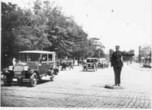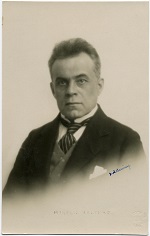
On November 18, 1918 the People’s Council of Latvia proclaimed a new state – the Republic of Latvia.
The country was in dire need for the establishment of a strong executive power that could bring order and security to Latvia that was ravaged by World War I. On November 19, Dr. Miķelis Valters became the first Minister of Interior in the newly formed Cabinet of Ministers. During these troubled times it was of great importance to establish an operational police force as well legislative basis regulating the operation of both the police and other units of the interior system.
On December 5, 1918 the People's Council of Latvia adopted the “Temporary Regulations on the Internal Security Organization”, which governed the establishment of said units. Nowadays, December 5 is celebrated as National police day.
Fragments no A.Žīgures grāmatas "Policijas vēsture"
Nonetheless, in the beginning of 1919, the Ministry of the Interior could not yet begin establishing the police forces, because the on-going warfare forced the government to move to Liepaja. The policemen that had already begun working mostly joined the army or fulfilled special military tasks. Only when the army had gradually begun to free Latvian regions, could the first police units of the independent Latvia undertake their activities. Police School was established under the authority of Riga Prefecture in 1919, due to the small number of trained professionals in Latvia. Its mission was to educate Latvian policemen. With the enhancement of the state of Latvia, also improved its police system - civil, criminal and secret police were established.
Noteworthy are the efforts of the Ministry of the Interior, at that time, to as soon as possible commence cooperation with other countries. In 1923, the Latvian Police begins to establish connections with the International Criminal Police, in 1926, in accordance with the international conventions the Criminal Police Board undertakes the fight against trafficking in women and children. In 1929, Latvian Criminal Police becomes a member of the International Criminal Police.
At that time the Ministry of the Interior had to address a whole range of different matters, for example, the responsibility of the Division of Emigrant and Refugee Transport was to deal with matters affecting the return of refugees to Latvia, as well as their transit through another country.
Shortly after that, the Ministry of the Interior established the Foreigners Division. Falling within their competence were matters related to foreign entry, stay and departure from Latvia. Due to its geographical location, Latvia became a kind of a bridge between East and West. This resulted in the relatively large number of foreigners in Latvia. As the situation in Latvia and its neighbouring countries stabilised, visa regimes with Estonia, Italy, Finland, Austria and Germany were abolished.
In the summer of 1919, Passport Division was established. The basic task of the Division was the issuance of passports to those citizens, which in accordance with the August 23, 1919 "Law on Citizenship” were granted citizenship.
During the same year, the Local Governments Division was founded that later became a Department with two Divisions - Rural Municipality Division and City Municipality Division whose main task was the formation of local governments and legislative basis. City Municipality Division was first engaged in taking care of the organization of city’s economic activities. In the following year, budgets (that were drawn up following the instructions of the Ministry of the Interior) were approved and appointed to Latvian cities and towns.
The Ministry of the Interior also participated in the restoration and development of Latvian economy. With the end of the hostilities, almost the entire economy of the country was destroyed; most public buildings were in ruins or in need of major repairs. The Ministry of the Interior supervised building renovation and new building construction works. For this reason, in 1921, was founded the Construction Board, which later was reorganized into the Construction Board of the Ministry of the Interior. It coordinated construction works and developed the appropriate laws and regulations. The Construction Board approved public and industrial building projects. The Ministry of the Interior monitored also the work of Latvian volunteer firefighters.
By winning the struggle for the right of self-determination, the Latvian people had gained the opportunity to build their country within its ethnographic borders. Therefore, had arisen a need for specialised forces to control the situation on the state borders and address matters related to border crossing.
Up until March, 1992 borders were guarded by the armed forces. Afterwards the task of border guarding was passed down to the Ministry of the Interior. The implementation of this reform greatly decreased the necessary maintenance expanses of the Border Guard. By cooperating the Department of Boarder Guard of the Ministry of the Interior and the Construction Board performed border construction and put up border signs. The central apparatus of the Ministry of the Interior coordinated and administered the work of these as well as many other government bodies.
The first Minister of the Interior of the Republic of Latvia and a remarkable political figure Miķelis Valters (1874 – 1968)
Dr. Miķelis Valters
18.11.1918.– 08.12.1919.
|
|
Latvijas Republikas pirmais iekšlietu ministrs un ievērojams sabiedriski politiskais darbinieks Miķelis Valters (1874 - 1968) |
Arveds Bergs
09.12.1919. – 18.06.1921.
Alberts Kviesis
18.06.1921. – 25.01.1923.
Pēteris Berģis
25.01.1923. – 26.06.1923.
Alfrēds Birznieks
26.06.1923. – 09.05.1924.
Pēteris Juraševskis
09.05.1924. – 17.12.1924.
Eduards Laimiņš
17.12.1924. – 17.12.1926.
28.01.1928. – 24.03.1931.
Marģers Skujenieks
17.12.1926. – 24.01.1928.
Ansis Petrēvics
24.03.1931. – 06.12.1931.
Jānis Kauliņš
06.12.1931. – 23.03.1933.
Gotfrids Mīlbergs
23.03.1933. – 17.03.1934.
Vilis Gulbis
17.03.1934.17.03 – 17.01.1939.
Kornēlijs Veitmanis
17.01.1939.– 20.06.1940.
On May 4, 1990 the Supreme Court of the Republic of Latvia adopted the Declaration “On the Restoration of Independence of the Republic of Latvia”.
People of Latvia regained the independence they had lost for more than 50 years, yet it still had to be defended. The Communist forces both in the USSR and in Latvia would not allow the strengthening the statehood of Latvia.
The employees of the Latvian Ministry of the Interior are to be accounted for their contribution in maintaining the state’s sovereignty. They formed an organized force to be reckoned by the opponents of Latvia’s independence. Alongside the developments made in the structure of the Ministry, attention had to be paid to the fight against the opponents of Latvia’s stabilization. In the period from 1990 to 1991, soldiers of the special operations unit OMON that was under Moscow’s command conducted several attacks on various objects of the Ministry of the Interior. On January 20, 1991 an assault was made on the building of the Latvian Ministry of the Interior. Two members of Militsiya on the Latvian side – Sergejs Konoņenko and Vladimirs Gamanovičs were killed protecting it. Several employees of the Ministry of the Interior were injured. Every year administration of the Ministry participates in the commemorative events of the January Barricades of 1991 at the Freedom Monument and at the memorial sites in Bastejkalns.
Aloizs Vaznis
04.06.1990. — 20.11.1991.
Ziedonis Čevers
20.11.1991. — 20.07.1993.
07.08.1997. — 09.04.1998.
Ģirts – Valdis Kristovskis
20.07.1993. — 28.10.1994.
Jānis Ādamsons
11.11.1994. — 21.12.1995.
Dainis Turlais
21.12.1995. — 10.07.1997.
Ziedonis Čevers
07.08.1997. — 09.04.1998.
Andrejs Krastiņš
04.05.1998. — 26.11.1998.
Roberts Jurdžs
26.11.1998. — 16.07.1999.
Mareks Segliņš
16.07.1999. — 30.09.2002.
Māris Gulbis
07.11.2002. — 09.03.2004.
Ēriks Jēkabsons
09.03.2004. — 21.10.2005.
Dzintars Jaundžeikars
03.11.2005. — 07.11.2006.
Ivars Godmanis
07.11.2006. — 20.12.2007.
Mareks Segliņš
16.07.1999. — 04.05.2000.
05.05.2000. — 30.09.2002.
20.12.2007. — 12.03.2009.
Linda Mūrniece
12.03.2009. — 02.11.2010.
03.11.2010. — 03.06.2011.
Rihards Kozlovskis
25.10.2011. — 06.11.2014.
07.11.2014. — 10.02.2016.
11.02.2016. — 23.01.2019.
Sandis Ģirģens
23.01.2019 — 03.06.2021.
Marija Golubeva
03.06.2021 — 16.05.2022.
Kristaps Eklons
26.05.2022 — 14.12.2022.
Māris Kučinskis
14.12.2022 — 15.09.2023.



